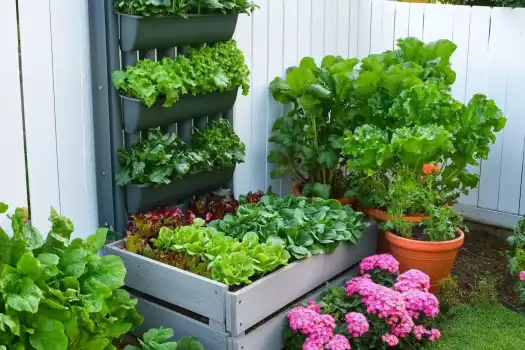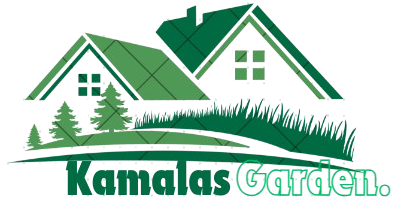Container vegetable gardening offers a great way to grow your own food even in small spaces. Whether you’re working with a balcony, patio, or a small backyard, this guide will help you set up and maintain a productive container garden for fresh, homegrown vegetables.

1. Benefits of Container Vegetable Gardening
Container gardening offers numerous advantages, making it an excellent option for small-space gardeners and beginners alike.
Space-Saving and Flexibility:
- Grow Anywhere: Whether you’re living in an apartment or have limited yard space, container gardening allows you to grow vegetables almost anywhere. This flexibility makes it easy to adjust the position of your plants to optimize sunlight exposure and protect them from harsh weather.
Perfect for Beginners:
- Simple Setup: Container gardening is straightforward and requires minimal equipment, making it the perfect entry into gardening for beginners.
Check out more tips on growing lettuce year-round in any space.
2. Choosing the Right Containers for Your Vegetable Garden
Selecting the appropriate containers is essential for the health and productivity of your plants. Different vegetables have different container requirements.
Container Types:
- Plastic, Ceramic, Terracotta, and Grow Bags: Each has benefits—plastic retains moisture well, terracotta allows for breathability, and grow bags are portable and flexible.
Size and Shape:
- Depth Matters: Deeper containers are better for root vegetables like carrots, while shallow containers work for leafy greens like lettuce.
Proper Drainage:
- Prevent Root Rot: Ensure all containers have drainage holes to prevent water buildup and promote healthy root systems.
3. Best Vegetables to Grow in Containers
Some vegetables thrive in containers, especially compact or dwarf varieties.
Dwarf and Compact Varieties:
- Cherry Tomatoes, Bush Beans, and Lettuce: These vegetables grow well in small spaces, providing high yields even in tight quarters.
Root Vegetables:
- Carrots, Radishes, and Potatoes: These need deeper containers for proper growth and are great for container gardens.
Climbing Plants:
- Cucumbers and Peas: Utilize vertical space by growing these plants with the help of trellises or stakes.

4. Soil and Potting Mix for Container Vegetables
Choosing the right soil is key to growing healthy, productive vegetables in containers.
Best Soil:
- Lightweight Potting Mix: Use high-quality, well-draining potting mix designed for container plants, not garden soil, to prevent compaction.
Adding Compost:
- Boost Soil Health: Incorporate organic compost to improve nutrient availability and soil structure.
Moisture Retention:
- Mulching: Add a layer of mulch to retain moisture and regulate soil temperature, especially during hot weather.
5. How to Set Up Your Container Garden
Setting up your container garden correctly will help ensure a productive growing season.
Finding the Right Spot:
- Full Sun or Partial Shade: Most vegetables need 6-8 hours of sunlight daily, so choose a spot with adequate light, or adjust the location of containers as needed.
Preparing Containers:
- Filling with Potting Mix: Ensure containers are filled with potting mix, leaving space at the top to avoid spillage during watering.
Spacing:
- Avoid Overcrowding: Leave enough space between plants for airflow and growth, preventing overcrowding, which can reduce yields.
6. Watering and Fertilizing Your Container Vegetables
Consistent watering and fertilizing are crucial for the success of your container vegetable garden.
Watering Tips:
- How Often: Water your vegetables when the top inch of soil feels dry, ensuring you don’t overwater or underwater. Containers tend to dry out faster than in-ground plants.
Self-Watering Containers:
- Consistent Moisture: Consider using self-watering containers for plants that need consistent moisture, like tomatoes.
Fertilizing Regularly:
- When to Feed: Use a balanced fertilizer every 2-4 weeks to keep your plants well-nourished and boost vegetable production.
7. How to Care for Your Container Vegetable Garden
Proper care ensures healthy plants and a productive harvest.
Pruning and Thinning:
- Encouraging Growth: Regularly prune dead or yellowing leaves, and thin seedlings to promote healthy growth and prevent overcrowding.
Managing Pests:
- Natural Solutions: Use organic pest control methods like neem oil, insecticidal soap, or companion planting to manage pests like aphids and caterpillars.
Supporting Tall Plants:
- Trellising and Staking: Provide support for tall plants like tomatoes or beans to prevent breakage and improve airflow around the plants.
8. Harvesting Vegetables from Your Container Garden
Harvesting at the right time ensures peak flavor and continued growth.
When to Harvest:
- Peak Flavor: Harvest vegetables when they reach the right size and maturity for the best flavor. For leafy greens, pick leaves regularly to encourage new growth.
Harvesting Techniques:
- Cut or Pick Gently: Use scissors or a knife to cut vegetables cleanly, or gently pick fruits to avoid damaging the plant.
9. Maximizing Yield with Succession Planting and Vertical Gardening
To get the most out of your container garden, use advanced techniques like succession planting and vertical gardening.
Succession Planting:
- Continuous Harvest: After harvesting one crop, plant a new one in its place to keep your garden productive throughout the season.
Vertical Gardening:
- Maximize Space: Use trellises, stakes, or cages to grow climbing plants upwards, allowing you to make the most of small spaces.
Frequently Asked Questions (FAQs)
Q: What vegetables are easiest to grow in containers?
A: Some of the easiest vegetables to grow in containers include cherry tomatoes, lettuce, radishes, and peppers. These thrive in confined spaces and require minimal maintenance.
Q: How often should I water my container vegetable garden?
A: Water when the top inch of soil is dry, which could mean daily watering during hot weather. Containers tend to dry out faster than garden beds.
Q: Can I grow vegetables indoors with containers?
A: Yes! Many vegetables, especially leafy greens and herbs, can be grown indoors with containers and grow lights.
Q: What are the best containers for growing vegetables?
A: Plastic pots, terracotta, or grow bags with proper drainage are ideal for container vegetable gardening.
For more tips on growing vegetables in containers, visit this comprehensive guide here.
Conclusion
Starting a simple and productive container vegetable garden is a great way to grow your own food, even in limited space. With the right containers, soil, and care, anyone can enjoy a bountiful harvest from their container garden. Get started today and enjoy the benefits of homegrown vegetables!


1 thought on “How to Start a Simple and Productive Container Vegetable Garden”